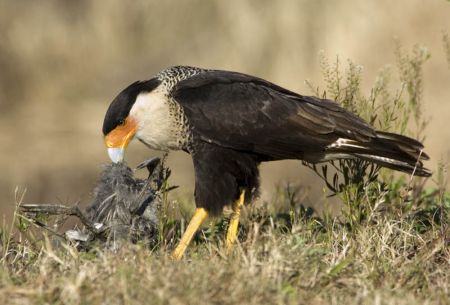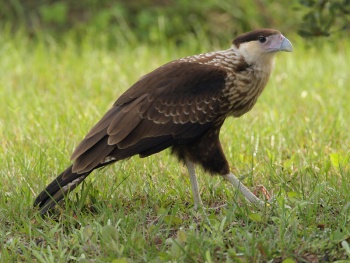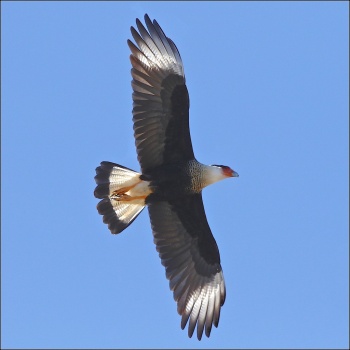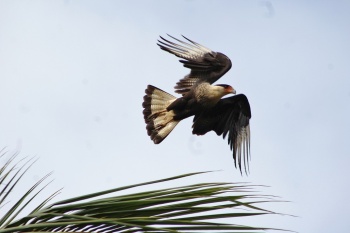Alternative names: Mexican Eagle, Mexican Buzzard
- Caracara plancus
Includes: (Northern) Crested Caracara; Southern (Crested) Caracara
Identification
A large caracara with a total length of 50-65 cm (20-26 in) and a wing-span up to 130 cm (51 in).
Individuals from the southernmost part of its range average the largest and those from tropical regions average the smallest, with birds in the northern end again being larger.
The cap, belly, thighs, most of the wings and tail-tip are dark brownish (may appear almost black), the ear-coverts, throat and nape are whitish-buff, and the chest, neck, mantle, back, uppertail-coverts, crissum and basal part of the tail are whitish-buff barred dark brownish.
In flight, some whitish-buff barring can be seen on a secondaries, while the outer primaries have a large conspicious whitish-buff patch ("window"), as in several other species of caracaras.
The legs are yellow, the bill is pale bluish-horn, the extensive bare facial skin and cere are deep yellow to reddish-orange (depending on mood and individual), and the iris is dark brown.
Juveniles resemble adults, but are paler, with streaking (not barring) on the chest, neck and back, grey legs, and whitish, later pinkish-purple, facial skin and cere.
Variation
The northern subspecies was split from the southern subspecies because of a number of differences in plumage. These include being white (vs buff) on chin, side of head and on neck, having less barring on the back and on the underside (not reaching as far to the rear), as well as fewer markings on the undertail coverts and the rump. However, recent reports indicate extensive hybridization where the two forms meet in the Amazonian area, and they have therefore been lumped back into one species.
Distribution
North, Central and South America.
In North America breeds in southern Arizona, southern Texas and east along the Gulf Coast into Louisiana and in south-central Florida. Also a rare breeder in southern New Mexico and breeds from Baja California and northern Mexico south to Panama.
In South America it occurs throughout most of the Guianas, Venezuela, Aruba, Trinidad, Colombia, Ecuador, Peru, Brazil, Bolivia, Chile and Argentina to Tierra del Fuego in south. It also occurs on the Falkland Islands. Also breeds in Cuba and the Isle of Pines and has occurred as a vagrant in Jamaica.
Common over most of range, but scarcer in the USA (it is classified as threatened in Florida).
Resident.
Taxonomy
Formerly considered as two species, of which the northern subspecies (cheriway) had the name Crested Caracara and the southern subspecies (plancus) was Southern Caracara. Recent reports indicate a large area of hybridization between these forms in Amazonia.
Sometimes also includes the now extinct Guadalupe Caracara.
Subspecies
There are 2 subspecies[1]:
- C. p. cheriway:
- C. p. plancus:
- Northern Chile and central Peru east to the mouth of the Amazon, south to Tierra del Fuego and the Falkland Islands; intergrades with nominate cheriway along the Amazon
Habitat
A range of habitats including arid scrubland and semi-desert, open woodland and riverine woodland, savanna with scattered trees, mangrove swamps and shorelines in some areas. Often near humans. Generally avoids densely forested regions (e.g. the Amazon), where largely restricted to the vicinity of rivers.
Behaviour
Diet
Often walks on the ground while feeding. This bird will feed on snakes, lizards, fish, turtle eggs, small mammals, and other live animals including insects, but will readily feed on carrion as well. The name in Spanish is Caracara Quebrantahuesos, which means bone breaker. They crack open and eat the marrow from carrion bones.
Breeding
Nests in trees, shrubs, or cactus. Usually lays two or three eggs.
References
- Clements, J. F., T. S. Schulenberg, M. J. Iliff, T. A. Fredericks, J. A. Gerbracht, D. Lepage, S. M. Billerman, B. L. Sullivan, and C. L. Wood. 2022. The eBird/Clements checklist of Birds of the World: v2022. Downloaded from https://www.birds.cornell.edu/clementschecklist/download/
- Birdforum Member observations
- Morrison, J. L. and J. F. Dwyer (2021). Crested Caracara (Caracara plancus), version 1.0. In Birds of the World (A. F. Poole, Editor). Cornell Lab of Ornithology, Ithaca, NY, USA. https://doi.org/10.2173/bow.y00678.01
Recommended Citation
- BirdForum Opus contributors. (2025) Crested Caracara. In: BirdForum, the forum for wild birds and birding. Retrieved 4 April 2025 from https://www.birdforum.net/opus/Crested_Caracara
Subspecies cheriway in flight
Photo © by Stanley Jones
Southeast of Belton, Bell County, Texas, USA, 13 May 2021Subspecies plancus
Photo © by Cristiano Crolle
El Palmar, Argentina, 27 July 2014
External Links
Search specifically for the northern subspecies:
GSearch checked for 2020 platform.1












